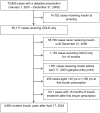Cancer specific mortality in insulin-treated type 2 diabetes patients
- PMID: 24667573
- PMCID: PMC3965531
- DOI: 10.1371/journal.pone.0093132
Cancer specific mortality in insulin-treated type 2 diabetes patients
Abstract
Aims: To test the hypothesis that cumulative exposure to insulin and long-acting insulin analogs might be associated with cancer mortality in diabetes patients.
Methods: All consecutive diabetes patients aged over 40 years, residing in a major urban area were screened at their first diabetes outpatient visit between 01/01/2001-12/31/2008 (n = 79869). Exclusion criteria were insulin treatment at screening, no insulin treatment until 12/31/2008, less than 6 months of glucose-lowering treatment alone before insulin initiation, insulin prescription before glargine became available, age <40/≥ 80 years at first insulin prescription, and <6 months of insulin exposure. A total 4990 subjects were followed-up for death based on death certificate, until 12/31/2011. Adjusted time-dependent competing risk regression analysis, with daily updates of treatment modalities was performed. Results are expressed for every 10,000 IU of cumulative dose or one year of cumulative time exposure to insulin.
Results: Mean baseline age was 62 ± 9 years, and follow-up 4.7 ± 1.9 years. Glargine cumulative dose was associated with lower cancer mortality risk (subhazard ratio, SHR: 0.94 (95%CI 0.89-0.99, p = 0.033)). Cumulative exposure limited to that attained one year prior to death revealed lower SHRs for cumulative time (0.94 (95%CI 0.89-0.99, p = 0.018)) and cumulative dose of glargine (0.92 (95%CI 0.86-0.98, p = 0.014)). Glargine cumulative time and cumulative dose were significant predictors for lower pancreatic and breast cancer mortality, but not for deaths from lung, colorectal, female genital, liver, and urinary tract cancer. No increased hazards were found for any other subtypes of insulins.
Conclusions: The cumulative dose exposure to insulin glargine was associated with a lower risk of cancer mortality in general, and of breast and pancreatic cancer in particular. This effect remained even after additional "fixed" cohort or propensity score analyses.
Conflict of interest statement
Figures
Similar articles
-
Cardiovascular Mortality in Type 2 Diabetes Patients with Incident Exposure to Insulin Glargine.J Diabetes Res. 2015;2015:962346. doi: 10.1155/2015/962346. Epub 2015 Jun 14. J Diabetes Res. 2015. PMID: 26176017 Free PMC article.
-
Risk of cancer in patients on insulin glargine and other insulin analogues in comparison with those on human insulin: results from a large population-based follow-up study.Diabetologia. 2012 Jan;55(1):51-62. doi: 10.1007/s00125-011-2312-4. Epub 2011 Sep 29. Diabetologia. 2012. PMID: 21956710 Free PMC article.
-
Risk of malignancies in patients with diabetes treated with human insulin or insulin analogues: a cohort study.Diabetologia. 2009 Sep;52(9):1732-44. doi: 10.1007/s00125-009-1418-4. Epub 2009 Jun 30. Diabetologia. 2009. PMID: 19565214 Free PMC article.
-
Long-Acting Basal Insulins: A Review of the More Recently Approved Agents.Cardiol Rev. 2019 Sep/Oct;27(5):260-266. doi: 10.1097/CRD.0000000000000266. Cardiol Rev. 2019. PMID: 31393288 Review.
-
Intermediate and long-acting insulins: a review of NPH insulin, insulin glargine and insulin detemir.Curr Med Res Opin. 2006 Dec;22(12):2613-9. doi: 10.1185/030079906X154178. Curr Med Res Opin. 2006. PMID: 17166343 Review.
Cited by
-
Hyperinsulinemia in Obesity, Inflammation, and Cancer.Diabetes Metab J. 2021 May;45(3):285-311. doi: 10.4093/dmj.2020.0250. Epub 2021 Mar 29. Diabetes Metab J. 2021. PMID: 33775061 Free PMC article. Review.
-
PATIENTS TREATED WITH INSULIN AND SULPHONYLUREA ARE AT INCREASED MORTALITY RISK AS COMPARED WITH THOSE TREATED WITH INSULIN PLUS METFORMIN.Acta Endocrinol (Buchar). 2017 Jul-Sep;13(3):329-333. doi: 10.4183/aeb.2017.329. Acta Endocrinol (Buchar). 2017. PMID: 31149195 Free PMC article.
-
A Prognostic Model to Predict Mortality among Non-Small-Cell Lung Cancer Patients in the U.S. Military Health System.J Thorac Oncol. 2015 Dec;10(12):1694-702. doi: 10.1097/JTO.0000000000000691. J Thorac Oncol. 2015. PMID: 26473644 Free PMC article.
-
Cardiovascular Mortality in Type 2 Diabetes Patients with Incident Exposure to Insulin Glargine.J Diabetes Res. 2015;2015:962346. doi: 10.1155/2015/962346. Epub 2015 Jun 14. J Diabetes Res. 2015. PMID: 26176017 Free PMC article.
-
Effect of hypoglycemic agents on survival outcomes of lung cancer patients with diabetes mellitus: A meta-analysis.Medicine (Baltimore). 2018 Mar;97(9):e0035. doi: 10.1097/MD.0000000000010035. Medicine (Baltimore). 2018. PMID: 29489653 Free PMC article.
References
-
- Jonasson JM, Ljung R, Talback M, Haglund B, Gudbjornsdottir S, et al. (2009) Insulin glargine use and short-term incidence of malignancies-a population-based follow-up study in Sweden. Diabetologia 52: 1745–1754. - PubMed
-
- Gerstein HC, Bosch J, Dagenais GR, Díaz R, Jung H, et al. (2012) Basal insulin and cardiovascular and other outcomes in dysglycemia. N Engl J Med 367: 319–328. - PubMed
MeSH terms
Substances
LinkOut - more resources
Full Text Sources
Other Literature Sources
Medical



